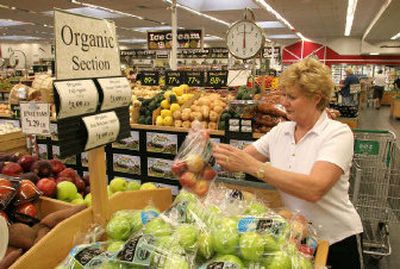Organic overload

WASHINGTON — No almonds. Big problem.
The makers of the high-energy, eat-and-run Clif Bar needed 85,000 pounds of almonds, and they had to be organic. But the nation’s organic almond crop was spoken for.
Eventually, Clif Bar found the almonds — in Spain. But more shortages have popped up: apricots and blueberries, cashews and hazelnuts, brown rice syrup and oats.
America’s appetite for organic food is so strong that supply just can’t keep up with demand. Organic means food is grown without bug killer, fertilizer, hormones, antibiotics or biotechnology.
“We’re doing a lot of scrambling,” said Sheryl O’Loughlin, CEO of Clif Bar Inc. “We have gotten to the point now where we know we can get a call for any ingredient.”
Organic products still have only a tiny slice, about 2.5 percent, of the nation’s food market. But the slice is expanding at a feverish pace. Growth in sales of organic food has been 15 percent to 21 percent each year, compared with 2 percent to 4 percent for total food sales.
Mainstream supermarkets, eyeing the success of organic retailers such as Whole Foods, have rushed to meet demand. The Kroger Co., Safeway Inc. and SuperValu Inc., which owns Albertson’s LLC, are among those selling their own organic brands. Wal-Mart Stores Inc. said earlier this year it would double its organic offerings.
The number of organic farms — an estimated 10,000 — is also increasing, but not fast enough. As a result, organic manufacturers are looking for ingredients outside the United States in places like Europe, Bolivia, Venezuela and South Africa.
That is no surprise, said Barbara Robinson, head of the Agriculture Department’s National Organic Program. The program provides the round, green “USDA Organic” seal for certified products.
Her agency is just now starting to track organic data, but Robinson believes the United States is importing far more organic food than it exports. That’s true of conventional food, too.
“That is how you stimulate growth, is imports generally,” she said. “Your own industry says we’re tired of importing this; why should I pay for imports when I could start producing myself?”
Even Stonyfield Farm, an organic pioneer in the United States, is pursuing a foreign supplier; Stonyfield is working on a deal to import milk powder from New Zealand.
“I’m not suggesting we would be importing from all these places,” said Gary Hirshberg, president and CEO of Stonyfield Farm Inc. “But for transition purposes, to help organic supply to keep up with the nation’s growing hunger, these countries have to be considered.”
The dilemma of how to fill the gap between organic supply and demand is part of a long-running debate within America’s booming organic industry. For many enthusiasts, organic is about more than the food on their plates; it’s a way to improve the environment where they live and help keep small-scale farmers in business.
“If organic is something created in the image of sustainable agriculture, we certainly haven’t accomplished that yet,” said Urvashi Rangan, a scientist for Consumers Union. “What people do have to understand is if that stuff comes in from overseas, and it’s got an organic label on it, it had to meet USDA standards in order to get here.”
The issue causes mixed feelings for Travis Forgues, an organic dairy farmer in Vermont.
“I don’t like the idea of it coming in from out of this country, but I don’t want them to stop growing organic because of that,” Forgues said. “I want people to say, `Let’s do that here, give a farmer another avenue to make a livable wage.”’
Switching to organic is a difficult proposition. Vegetable grower Scott Woodard is learning through trial and error on his Putnam Valley, N.Y., farm. One costly mistake: Conventional farmers can plant seeds when they want and use pesticides to kill hungry insect larvae. If Woodard had waited three weeks to plant, the bugs that ate his seeds would have hatched and left. Organic seeds can be double the price of conventional.
“There’s not a lot of information out there,” Woodard said.